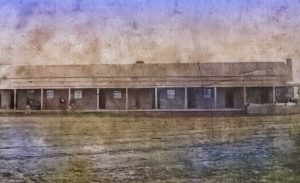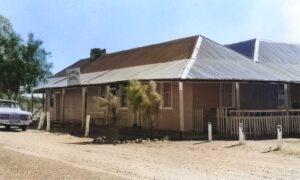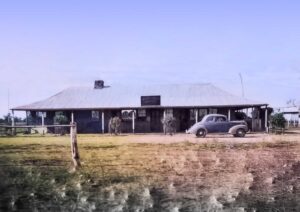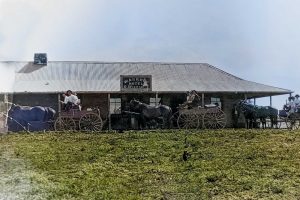McAuliffe held large tracts of pastoral land along the Warrego and was the first holder of “Kerribree”, which he later sold to Willliam “Baldy” Davis. By the time McAullife opened his hotel he had already amassed considerable wealth.
In 1875, McAuliffe backed a party of speculators in the race for grazing land around Coopers Creek, taking up some 250 square miles of country for himself. A semi-fictionalised account of this land grab in the interior, written in 1906 by H.K Bloxham, a former Mayor of Bourke, provides an interesting character study of McAuliffe and a glimpse of life in the Salmonford Hotel.
Bloxham describes McAuliffe as “a rough-and-ready Irishman” who was much respected and looked up to in the district.
“He still, however, retained a roadside hotel,” writes Bloxham, who uses the thinly veiled pseudonym ‘Tim McCauley’ in place of ‘Michael McAuliffe,’ “a building of no more than twelve or fifteen rooms, situated on the main highway from Bourke to the new country which was now being rushed by speculators from Sydney, Melbourne and Adelaide.
“McCauley, like many worthy citizens of his day, was addicted to periodical sprees. He went on what was locally known as the burst about every six months, and kept it up for a fortnight, and, when he was recovering, always vowed that, as soon as he got straight again, he would never touch a drop of the ‘darned stuff’ again.
“But the habit of a lifetime was not to be broken, and though he weaned gradually to ‘soft stuff’ such as sarsaparilla and lime juice he could never refuse a drink, unless for some better reason than that he was not thirsty.
“After a time he would say, ‘Sure, a drop of claret won’t hurt anyone.’ In a week he would tire of claret, and sherry would become the favourite liquor. Then, to rectify the effects of the sherry, he would take a medicinal drop of schnapps with homemade soda water.
“Everyone knows that bottled ale is a good variant with schnapps; and so he would permit himself beer and schnapps for a month or two. Such comparative abstemiousness merged into moderate whisky-drinking by degrees — a nightcap after a game of cards being the usual opening. Whisky displaced the less seductive potions, and for another month a dozen to twenty whiskies would be consumed each afternoon and evening.
“If he had stinted himself to this allowance he would have been all right, for he could carry it easily without losing his mental or physical balance. But there would certainly come a time when he would take a drop too much overnight; feel out of sorts in the morning; miss his breakfast, and have a nip instead.
“Then he would have no more breakfasts for a fortnight, and little but whisky and milk through the day, with a heavy, indigestible supper late at night. Jovial at all times, his joviality increased with his potations. Generous always, he not only fed travellers when he was on the spree, but ‘shouted’ for them at the bar. He said he hated ‘to drink with the flies’; abhorred a ‘Jimmy Woodser’; and did not care whether a traveller was a ‘cheque man’ or a ‘stony broker.’
“His advent was invariably an excuse for another drink or two. Mrs McCauley and the girls wished him to give up the hotel and to live on one of his many properties, and his son, a sober, manly young fellow, urged him to the same course, but old Tim was hard to shift. He would be lost, he said, unless he had the boys coming along the track to keep him alive. He paid for all the drinks he got, and was treated just the same as any other customer.
“When drinking, he kept clear of the cottage, and the girls saw little of him. Mrs McCauley managed the hotel, and had plenty of assistance. She was so used to the state of affairs that I almost believe she would have wearied of a life of quiet retirement almost as soon as Tim himself.
“Tim, no matter how drunk he might be, he never spoke a rough word to her, not indeed to anyone, unless they were, as he said, ‘looking for lash.’
“The barman – a steady, middle-aged, reliable man, who had been with the McCauleys for years the groom, also an old servant, and even the Chinese cook, were all devoted to Tim; whilst the servant girls, of whom two were employed in the hotel and one in the cottage, looked upon him almost as a father.
“He treated them well, and saw that they were properly treated by his various guests. No man drunk or sober, was allowed to say a rude word in their presence; and Tim had, perhaps, more rows with strangers on this account than any other.
“Only strangers would venture to be offensive, for all the district men remembered how Tim had thrashed Mick Keogh and then lashed him to the rope of the fifty-feet-deep well at the back of the hotel, lowered him down twenty feet, chained and padlocked the handle of the windlass, and kept the key for three hours, till Mick howled out a piteous apology for some slighting words addressed to one of the girl-servants. Mick was a bullock-driver and a bruiser; but Tim McCauley was able to manage him single-handed.”
McAuliffe did finally give up the Salmonford Hotel in 1879, but only to head north to Queensland and settle in Eulo, where he briefly held the licence of the town’s only hotel. McAuliffe died the following year on 20 May 1880.
The old Salmonford Hotel was held by a series of publicans over the next 30 years, but in 1912 it was purchased by a German named Bernard Wilkie, who had previously been the publican at Gumbalie. It was Wilkie who built the mud brick building on the Western side of the river, officially transferring the license from Salmonford to his newly named Warrego Hotel in early 1914.
Today

Warrego Hotel
Call into the historic Warrego Hotel, built in 1913 and thought to be the only pub in Australia still standing constructed of mud bricks. The pub also rests on the site of the Cobb and Co changing station, where the legendary stage coaches swapped out their horses for a fresh team.





